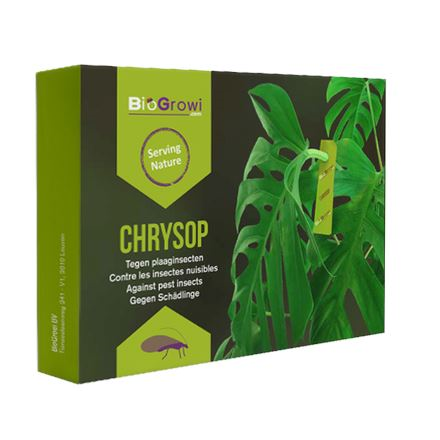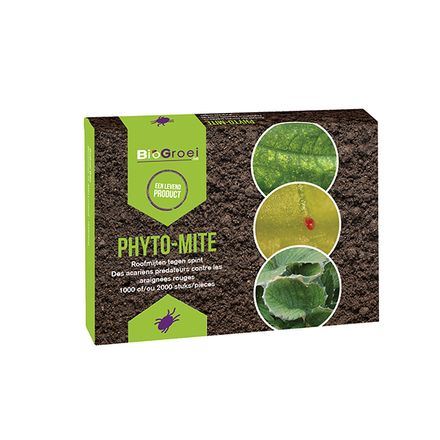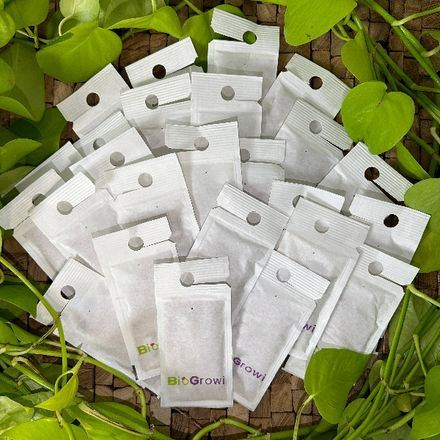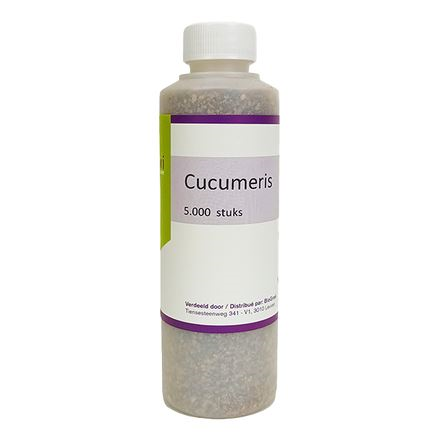
Control and prevent aphids, mealy bugs, thrips and other pests on your houseplants
Pests and diseases are certainly not exclusive to outdoor plants. They can also affect houseplants. If your houseplant suffers from an aphid or blowfly infestation, it does not necessarily signal poor care of your plants. Poor placement, transmission via pets or yourself, or leaving a door open for a while can also cause your plants to endure an infestation. Fortunately, controlling and preventing an infestation on your houseplants is usually quite easy, at least if you catch it in time.
Aphids

Aphids are a real pest on houseplants. They measure between 1 and 7 mm, are usually black, white or green (exceptionally also yellow, red or purple) and have a soft, pear-shaped body, with two protuberances at the abdomen.
They poke a hole in the leaves of your plants and then feast on the plant sap. This obviously damages the leaves and unbalances the plant. The plant weakens and because of the damage, deformations are possible which makes the plant visually a lot less attractive. Aphids reproduce very quickly. In no time, an aphid infestation can have your plant in its grip. Fortunately, controlling an infestation of aphids is relatively easy.
Aphids secrete honeydew. This is a sticky substance that can also attract ants. And you definitely prefer to keep them out of your home. In addition, this honeydew can cause sooty mould. This creates black spots on the leaves. Aphids are usually found on plants with soft leaves (which are easier to sink their teeth into) such as the calathea, alocasia or peace lilies.
Control aphids on houseplants
A first way to control aphids on your houseplants - and prevent other plants from falling prey to them! - is to put your houseplant outside for a while. Outside, there are more natural enemies that would love a tasty aphid snack. Moreover, they do not like the cold and rain. Keep in mind that the weather should not be too bad either. After all, houseplants do not like low temperatures and wet weather either. Using a jet of cold water indoors will also go a long way. You can also rub off aphids on your houseplants by hand. See that leaves are already damaged? Cut them away immediately to give your plant every chance to recover properly.
Preventing aphids on houseplants
Aphids can fly. Consistently using screens for windows and doors is therefore a no-brainer. These little undercreepers will look for easy prey (read: already weakened plants). So it is advisable to take good care of your plants with fertiliser. Don't forget to prune your plant in spring and put it in a good spot. Aphids thrive better in a space with dry air.
Fungus gnats
Fungus gnats are not a pest on your houseplants themselves, but they are in their potting soil. Technically, fungus gnats are not flies but mosquitoes.
You notice the presence of fungus gnats best when watering. If there is a plague of fungus gnats, they will fly up en masse when watering. They are 3 to 5 mm in size and like a moist, warm environment in potting soil. The flies are very annoying, but do little damage.
The larvae of fungus gnats is a different story. These are 5 to 12 mm, white-transparent in colour with a black head. Young larvae eat rotting material, algae and fungi in the potting soil. Larger larvae eat root hairs, soft roots or even entire young plant stems. This damage makes it easier for fungi to gain a foothold on the plant. Seedlings, cuttings and young plants are especially susceptible to sciarid flies, especially if they are in heated conditions. Potted azalea or begonia, among others, are also quickly affected by fungus gnats.

Control fungus gnats
Fungus gnats in your houseplants can easily be controlled naturally. The flies themselves barely live for a few days. It is therefore better to tackle the problem at an earlier stage. Using nematodes, you fight the larvae. These nematodes secrete a fungus that causes the larvae to die.
You can also use these nematodes in combination with solution two: sticky traps. These are (usually yellow) plates with natural glue. The flies stick to them and die.
Let your plant dry out well before watering again. Fungus gnats like moist soil. By drying out your plant, you create a habitat they don't like. However, this is a fine balance. Drying out your plant for too long and too much is not good either.
Preventing fungus gnats
Between waterings, it is best to let the potting soil dry out well. Can you see and feel that the soil is still damp? Then it's best to postpone watering for a day. Watering too much is not good for a plant anyway. It often results in root rot.
Fungus gnats and larvae most often enter via a new plant or potting soil. It is therefore best to place new plants in quarantine in a separate room for 1-2 weeks. That way, your other plants cannot become infested. If fungus gnats have already come along, the infestation will remain extremely limited and you won't need to treat all your houseplants for fungus gnats.
Mealybug
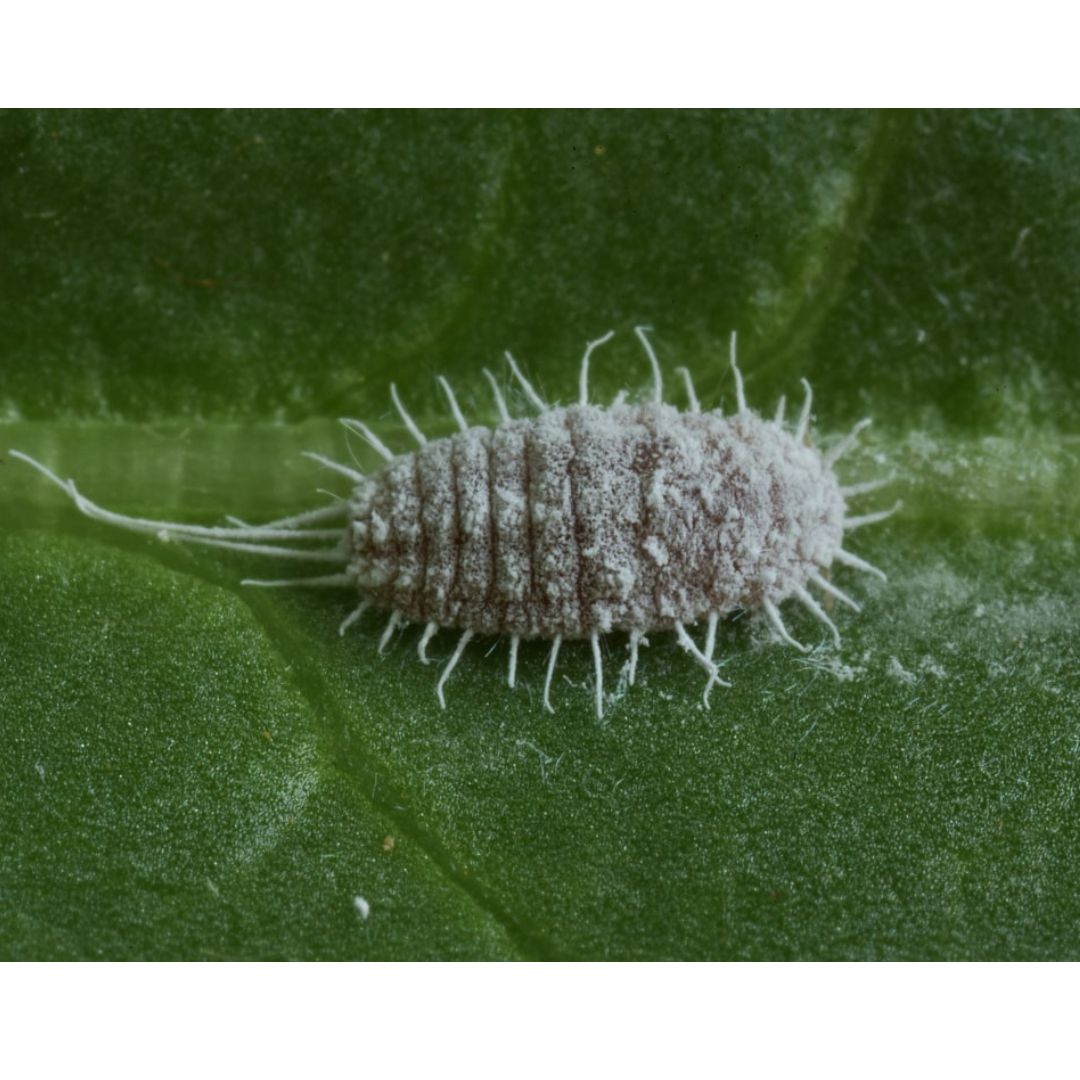
A mealybug is a small insect about 3 to 6 mm in size that appears to be coated in a white powdery layer. Females produce a white, woolly secretion. The mealybug is most common on houseplants such as bromeliads or orchids, but also on cacti.
Mealybugs are not harmful to humans, but your plants suffer quite a bit. These white rascals feed on various plant parts, causing loss of nutrients. The mealybug also leaves behind a secretion and honeydew which attracts fungi. This too will weaken the plant. Moreover, ants also love honeydew. Mealybugs like a humid environment with lots of draughts.
Controlling mealybugs
Mealybugs on your houseplant can be controlled with simple remedies. Fill a plant sprayer with water and add a dash of washing-up liquid. Shake well and then spray the entire plant with this soapy water. Repeat after a week if necessary. Of course, you can also immediately use an organic insect spray or use their natural enemies. The lacewing is a natural enemy of the mealybug, among others. Their larvae literally eat the mealy bug.
Preventing mealy bug
The easiest way to prevent mealy bug on your houseplant is to make sure it is in optimal condition. Provide sufficient light, water (not too much) and nutrients. The mealybug spreads through clothing or there contact with another infected plant.
If one of your houseplants is infested with the mealybug, place it in quarantine immediately. Check new plants thoroughly. After touching an infected plant, always wash your hands before coming into contact with other plants.
Scale insect
Scale insects are barely 1 to 3 mm in size, but you can still see them with the naked eye. This is because they often live in large groups. You can recognise a scale insect by its horny shell. Scale insects suck on the leaves of your plant after which it injects a toxic substance into your houseplant. Plants with a woody stem are particularly susceptible and it also likes to stay on somewhat older plants. The scale insect can also be found on orchids and all kinds of palm species. Scale insects also find very calcareous soil extremely fine.
Controlling scale insects
Controlling scale insects on your houseplants is very similar to controlling mealybugs. Using a plant sprayer filled with water and a dash of washing-up liquid will go a long way. Be careful not to make the potting soil too wet. The water spray should also be hard enough to remove all the scale insects that cling to the leaves. Another remedy is dabbing with alcohol. Soak a cotton swab in alcohol and dot the scale insects one by one. Within a minute, you will find it easier to remove them manually. An organic insect spray is always a possible solution to combat the presence of scale insects on your houseplant.

General tips against lice in houseplants
Want to prevent lice in your houseplants? Then the best actions to take depend on each louse. The actions below work against most lice on plants.
- Strong-smelling plants: Lice often hate the smell of strong-smelling plants such as sage. If you place these plants near your infested plants, most lice will stay away.
- Cold water: Spray your houseplants regularly with cold water, this will wash away lice.
- Manual action: Regularly check the plants in your room and immediately remove found lice manually.
- Enough fresh air: woolly and scale insects are more likely to occur in a room with dry air or on plants where draughts have free rein.
- Provide enough nutrients: woolly aphids and scale insects occur in plants that are less vital. You can prevent this by providing your houseplant with sufficient nutrients and water.
Spider mite

Spider mites and aphids are very similar in appearance, but spider mites are definitely not aphids. They are actually mites that are often found on the underside of your houseplant's leaves. They feed on leaf juices by poking holes in the leaf. This causes leaves to develop yellow-brown spots. Very fine cobwebs can also be a sign that your plant is suffering from spider mites. The 'cobweb' seems to be thrown haphazardly on the plant, instead of following a nice structure like that of a spider.
Spider mite control
Spider mites are best controlled using water. Fill a plant sprayer with water and literally chase the mites away with a jet of water. It is best to cut away the worst affected parts of your plant to give the healthy parts every chance. You can also let their natural enemies do the work. Predatory mites actively hunt spider mites, stopping the infestation.
Spider mite prevention
Proper misting with the plant sprayer not only chases away spider mites if there are any, but also works preventively. Mites like it dry and warm. You should also repot your plants often enough, or at least add a layer of fresh potting soil. Mites thrive in old, exhausted potting soil.
Thrips
Thrips look a lot like fungus gnats, but are different. They cannot necessarily fly well, but do use their little wings to jump from one plant to another. The larvae of thrips live on the leaves of your houseplants and feed on sap from the leaves. The result is golden or silvery spots. Thrips have a long, thin body and do not grow larger than 2 mm. They can be brown or black. Larvae of thrips are yellow-white in colour and do not yet have wings. In the first stage, they are barely half a millimetre in size. Small buggers, then, that can have big consequences.
Fighting thrips
The first step to take if you discover thrips on one of your houseplants is to isolate that plant immediately! Then start working with sprays or natural enemies. Breeding bags or scatter boxes containing predatory mites or predatory bugs are an excellent solution in that respect.
Preventing thrips
Thrips like areas with low humidity. To prevent thrips from attacking your plant, spray them regularly with a plant sprayer. Nutrients, too, are extremely important. A weakened plant is less able to defend itself against pests, so a pest also spreads more quickly.

Moulds
See mould appearing on the potting soil of your houseplants? Can happen, this certainly does not mean you are not taking good care of your plants. A houseplant needs oxygen, nutrition and water. And let that be exactly what mould also likes. Mould in potting soil is usually caused by the potting soil being too moist. This can also cause root rot. Combine moist potting soil with high humidity and low air circulation, and moulds soon rear their heads.
A white deposit on your potting soil does not necessarily mean mould. Water from the tap contains a lot of lime, so it may as well be lime. This is harmless for your plant. Lime has a dry, grainy texture, while mould on your houseplant has a foul smell and is rather fluffy.
Fighting mould
- Remove mould on potting soil: Scoop the part of the potting soil that has mould on it out of the pot and throw it away.
- Repot plant with new potting soil: Is there too much mould present? Then it is better to repot your plant immediately and use new potting soil. Of course, you can reuse the flower pot after you have cleaned it thoroughly.
Preventing mould
- Let the top layer of potting soil dry thoroughly before re-watering your houseplant.
- Prune your plant in spring.
- Provide sufficient nutrients. This gives the your houseplant energy to fight a fungus and thus prevent fungus from spreading.
- Put the plant in the right spot. Most plants prefer a sunny spot. Of course, you should consider the ideal location for your plant.
General tips to prevent pests
- Install mosquito nets so that, for example, thrips, aphids and whiteflies cannot fly inside
- Clean old flower pots thoroughly before reusing them, e.g. with water and vinegar
- Do not place plants too close to a radiator
- Prune plants in spring
- Remove dead plant debris
- Find out what care the plants need and where they feel most comfortable. This can be found on the plant label.
- Watch out for contamination via secateurs, your clothing... A common mistake is not cleaning the secateurs you use to cut away infected leaves before pruning a healthy plant. Cross-contamination via clothing, pruning shears or simply because infected plants are too close to healthy plants is very common.
Want to know more about caring for houseplants? Read all about it here 👇
More info? Receive all our gardening tips directly in your mailbox!
We'll only email you handy facts, green advice and our best promotions & discounts. You'll receive it about once a week and you can unsubscribe at any time. No spam, promise 🤞












